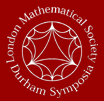|
|
London Mathematical Society - EPSRC Durham Symposium
|
Mathematics of Data Assimilation
|
Monday 1st August - Thursday 11th August 2011
|
|
Topics of the symposium
- The representation of non-Gaussian statistical models of the assumed uncertainties within the data assimilation process. This is necessary when treating very nonlinear processes and has led to the development of several nonlinear filtering techniques, which aim to sample the underlying probability distribution, based on statistical sampling techniques. However, most methods currently available are unsuitable for very large problems arising in industrial applications, due to prohibitive computational cost. New nonlinear filtering techniques for state and uncertainty estimation in high dimensional systems need to be developed.
- The representation of uncertainty estimates for the application of current data assimilation methods based on Gaussian statistics. Estimates of model states and parameters from data assimilation are very dependent on the assumed uncertainties in the inputs, including uncertainties in the prior estimates, the observations and the mapping between the model state space and the observation space. Methods for representing these uncertainties in assimilation schemes require knowledge of both the mathematics of data assimilation and the physics of the problem being modelled. The interaction between mathematics and applications will allow the development of novel methods for representing uncertainty in data assimilation. A further aspect of this work is the need for new methods for quantifying uncertainty in the outputs given the input uncertainties. Such an understanding is required if the results of data assimilation are to be used successfully within industrial applications.
- The use of data assimilation with imperfect models. Numerical models of physical systems inevitably contain errors, including both biases and random errors, which arise, for example, from the use of approximate equations, the numerical solution of these equations and the limited spatial and temporal resolution of the computational models. However, it is not clear how best to take account of these errors in data assimilation systems. Some initial work in this area has been undertaken in both in variational data assimilation and, more recently, with the application of variational inference techniques in stochastic systems as part of the EPSRC funded VISDEM project. However, much more work is needed to understand the model error characteristics in new application areas and to represent this uncertainty in data assimilation schemes.
- Intelligent monitoring, or sensitivity of the posterior pdf to observation networks. Where to place observations to narrow the posterior pdf as much as possible is a highly nonlinear problem, which is of vital importance for practical applications due to the high costs associated with observations of the real world. Present-day techniques are based on linearizations that need further refinement. Also, because the error covariances in operational applications tend to be used as control variables, a proper evaluation using Bayes theorem is not possible. Furthermore, the full nonlinear problem has not been addressed in any detail, and sophisticated methods are desperately needed.
|
Organising Committee:
Ian Roulstone (University of Surrey), Peter-Jan Leeuwen (University of Reading), Nancy Nichols (University of Reading)
|
|

